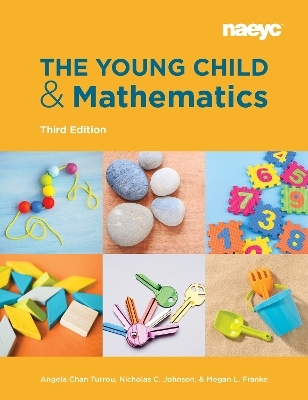
The Young Child and Mathematics, Third Edition
National Association for the Education of Young Children (Verlag)
978-1-938113-93-2 (ISBN)
of Child-Led Math Teaching and Learning
Winner of the 2022 Excel Silver Award for Technical Book. Everything a child does has mathematical value—these
words are at the heart of this completely revised and updated third edition of The Young Child and Mathematics.
Grounded in current research, this classic book focuses on how teachers working
with children ages 3 to 6 can find and build on the math inherent in children’s
ideas in ways that are playful and
intentional.
This resource
·
Illustrates through
detailed vignettes how math concepts can be explored in planned learning
experiences as well as informal spaces
·
Highlights
in-the-moment instructional decision-making and child–teacher interactions that meaningfully and dynamically
support children in making math connections
·
Provides an
overview of what children know about counting and operations, spatial
relations, measurement and data, and patterns and algebra
·
Offers examples of
informal documentation and assessment approaches that are embedded within
classroom practice
Deepen your understanding of how math is an integral part
of your classroom all day, every day.
Includes online
video!
Angela Chan Turrou, PhD, is senior researcher and teacher educator at the University of California, Los Angeles (UCLA) Graduate School of Education and Information Studies. Her work lives at the intersection of children’s mathematical thinking, classroom practice, and teacher learning. In her work with teachers and teacher educators across preschool and elementary settings, Angela leverages purposeful Instructional Activities driven by children’s mathematical thinking to support teacher learning, collaboration, and generative growth. She is continually inspired by teachers who, on a daily basis, create space for children to drive the mathematical work and challenge the broader discourse of who does and does not get to be “good at math.” Angela is coauthor of Young Children’s Mathematics: Cognitively Guided Instruction in Early Childhood Education (Heinemann, 2017) and coeditor of Choral Counting and Counting Collections: Transforming the PreK–5 Math Classroom (Stenhouse, 2018). Angela lives in Los Angeles, CA. Find her on Twitter @Angelaturrou. Nicholas C. Johnson, PhD, is assistant professor in the School of Teacher Education at San Diego State University (SDSU). His work investigates how classrooms shape children’s opportunities to participate and learn. A former classroom teacher, instructional coach, and county office coordinator, Nick partners with new and practicing teachers to explore children’s mathematical ideas and expand what “counts” as math in school. He is a member of SDSU’s Center for Research in Mathematics and Science Education, coauthor of Young Children’s Mathematics: Cognitively Guided Instruction in Early Childhood Education (Heinemann, 2017), and a contributor (with Natali Gaxiola) to Choral Counting and Counting Collections: Transforming the PreK–5 Math Classroom (Stenhouse, 2018). Nick lives in San Diego, CA. Find him on Twitter @CarrythZero. Megan L. Franke, PhD, is professor of education at UCLA. Dr. Franke’s work focuses on understanding and supporting teacher learning for both preservice and in-service teachers. She is particularly interested in how teaching mathematics with attention to students’ mathematical thinking (Cognitively Guided Instruction, or CGI) can challenge existing school structures and create opportunities for students who are often marginalized to mathematically thrive. Dr. Franke is a member of the Development and Research in Early Mathematics Education (DREME) Network at Stanford University where she is studying pre-K–2 coherence and designing resources for early childhood teacher educators. She lives in Santa Monica, CA. Find her on Twitter @meganlfranke.
Preface
About
this Edition
Our Theory
of Learning
Introduction
Everything
a Child Does Has Mathematical Value
Finding
and Building on the Mathematical Value
An Overview
of this Book
Engaging
with this Book
Chapter 1: Counting and Operations
Instructional Activity: Counting Collections
Exploring Children’s Thinking: Counting
Exploring Children’s Thinking: Operations
Assessing Children’s Understanding
Counting and Operations in Informal Spaces
Conclusion
Chapter 2: Spatial Relations
Instructional
Activity: Describe-Draw-Describe
Exploring Children’s Thinking: Describing Spatial
Relations
Exploring Children’s Thinking: Representing Spatial
Relations
Assessing Children’s Understanding
Spatial Relations in Informal Spaces
Conclusion
Chapter 3: Measurement and Data
Measurement
and Data in Informal Spaces
Instructional Activity: What Do You Notice?
Exploring Children’s Thinking: Measurement
Exploring Children’s Thinking: Data
Assessing Children’s Understanding
Conclusion
Chapter 4: Patterns and Algebra
Exploring
Children’s Thinking: Creating and Extending Patterns
Assessing Children’s Understanding: Tea Party Patterns
Exploring Children’s Thinking: Patterns in Counting
Assessing Children’s Understanding: How High Can
Christopher Count?
Exploring Children’s Thinking: Patterns and Algebra in
Storybooks
Assessing Children’s Understanding: Storybook Patterns
Conclusion
Appendix A: A
Research Overview of What Young Children Know
What Young
Children Know: Counting and Operations
What
Young Children Know: Spatial Relations
What Young Children Know: Measurement and Data
What Young Children Know: Patterns and Algebra
Situating What a Child Knows
Appendix B: Using this Book to Support Professional Learning
Bringing
an Instructional Activity into Your Classroom
Making Connections Across Math
Content
Exploring Informal Spaces
Creating Classroom Spaces that
Support Participation
Connecting Classroom Practice to Research
Connecting Theory to Practice
Connecting to Policy and
Standards Documents
References
Index
Acknowledgments
About the Authors
| Erscheinungsdatum | 06.08.2021 |
|---|---|
| Zusatzinfo | color illustrations throughout |
| Verlagsort | Washington DC |
| Sprache | englisch |
| Maße | 212 x 276 mm |
| Themenwelt | Sozialwissenschaften ► Pädagogik |
| ISBN-10 | 1-938113-93-4 / 1938113934 |
| ISBN-13 | 978-1-938113-93-2 / 9781938113932 |
| Zustand | Neuware |
| Haben Sie eine Frage zum Produkt? |
aus dem Bereich


